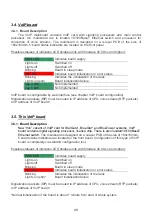
10
Up to 64 SIM cards –
each GSM board contains 16 SIM card holders. However, two SIM
cards are only connected to the GSM modules at one moment. An intelligent SIM card switching
according to time, at random intervals, according to completed minutes or sent SMS enables a
client-oriented approach. A defective SIM card blocking is a matter of course.
World wide use–
GSM/3G boards are currently available with GSM modules from
Siemens TC35i (900/1800MHz), MC55i (850/900/1800/1900MHz) and Wavecom
(850/1900MHz or 900/1800MHz). 3G modules SierraWireless (All UMTS and GSM bands).
Virtual SIM card support – PRIGW supports
2N SIM Star system
.
One antenna per system only
– One
receive/transmission antennas can be used in
combination with an antenna splitter (see below) for all of up to 16 GSM modules.
Gateway Number
of
antennas
with using antenna splitter
StarGate 2
BlueStar 1
BlueTower 1
Hot-swappable boards –
as mentioned above, all GSM boards are hot-swappable. As a
matter of course, the access to the GSM board can be restricted upon the user‘s request. This
solution provides an easy SIM card replacement during operation.
Support Callback –
PRIGW supports to make call to GSM and after connection make call to
PRI interface and connect both calls. This feature can be controlled by AT command or XAPI server
SW (easy to implement it to some additional callback SW, or you can use 2N callback software)
CLIP routing
– according incoming CLIP from GSM network the gateway can route the
call to defined number in PRI ISDN
AutoCLIP routing
– PRI GW can store Calling and called numbers in case of outgoing call
to GSM network. In case that somebody calls from GSM network and have CLIP same as stored
Called number, the gateway will automatically reroute the call to defined PRI ISDN number.
2x PRI ISDN interface –
is configurable in all available modes, i.e. as Network
Termination (NT), or Terminal Equipment (TE). It can also be set as a Master (synchronization
clock) or a Slave. Using PRI board switches you can easily select RX and TX directions –
hence, you can use a cross-over or not-cross-over cable for the PRIGW <> PBX (Switch)
connection.
VoIP interface
– supporting SIP signaling and following codec: G.711, G.723, G.729. With
using VoIP interface you can use only one PRI ISDN interface***.
Easy control and configuration –
The PRIGW can be configured locally or remotely. To
do this, you can employ the following types of connection:
•
2 local RS232 interfaces;
•
remote control by an external analog, ISDN, or GSM modem connected to
a defined RS232 interface. Automatic detection and configuration capacities make
the modem perfectly available.
•
remotely via a 10baseT IP interface, using a simple Telnet protocol;
•
remotely by the in-band B channel in the PRI-ISDN interface**.
Содержание 2N BlueStar
Страница 2: ......
Страница 42: ...40 After it the system will save new firmware fo EEPROM memory and makes restart ...













































